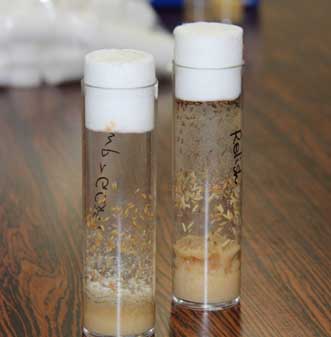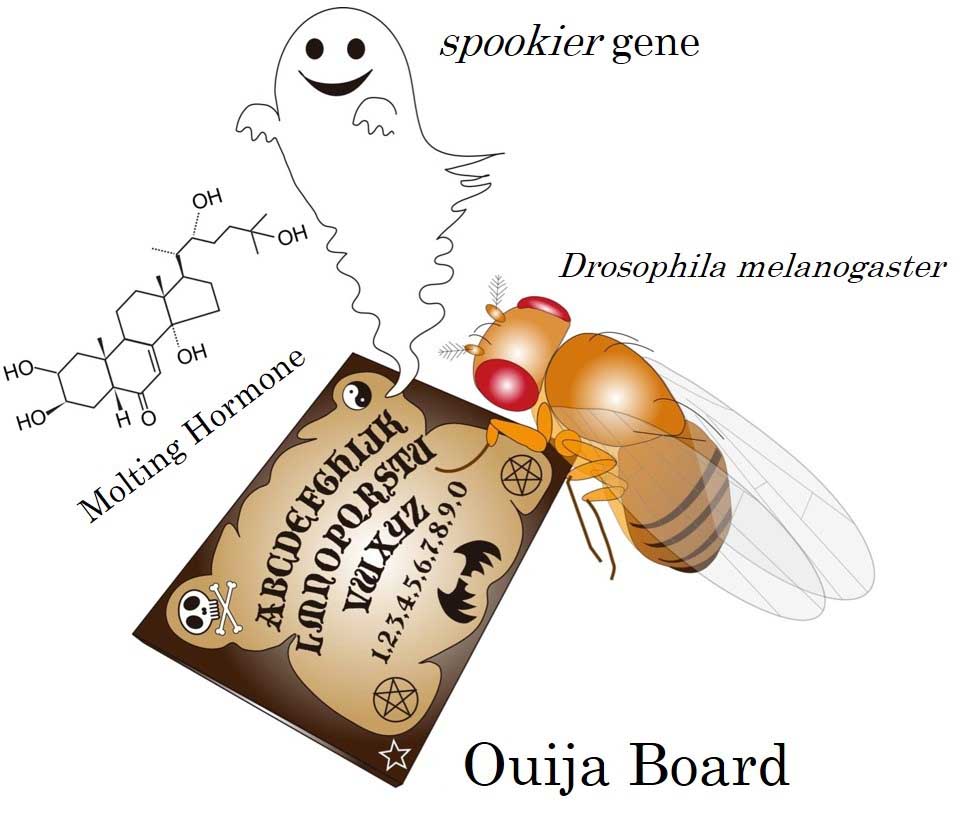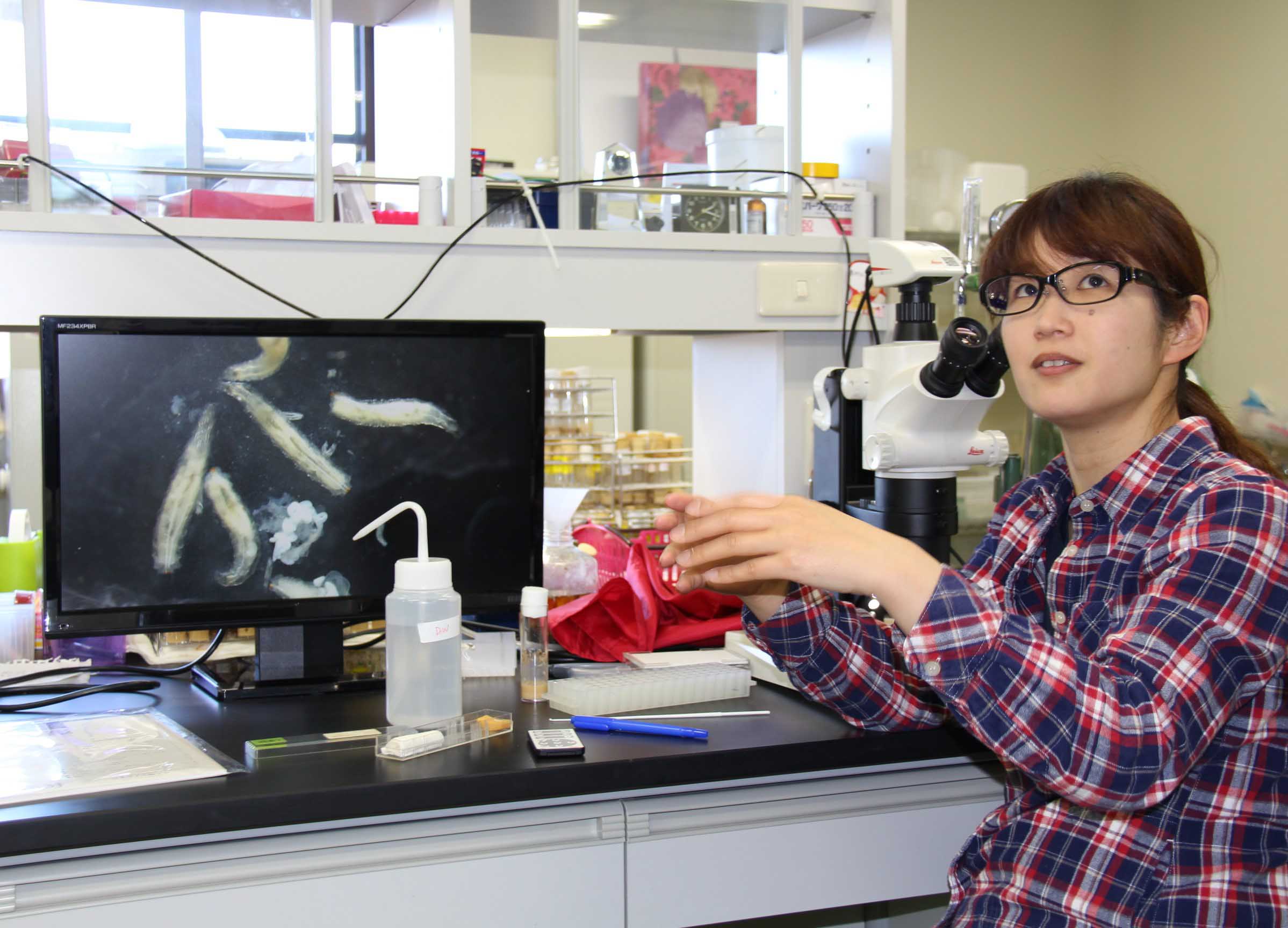TSUKUBA FUTURE
#092 My dear fly: Drosophila melanogaster
Assistant Professor SHIMADA Yuko, Life Science Center for Survival Dynamics (TARA)

Adequate nutritional intake is essential for healthy growth. In recent years, however, issues like obesity and precocious puberty in children due to excessive nutrient intake have come to the fore in advanced countries. The importance of nutrition is the same for humans and insects. Among insects, a poor nutritional environment leads to delay in larval growth, and death due to the inability to molt or undergo metamorphosis. Professor Shimada is engaged in research at the molecular level using the fruit fly (Drosophila melanogaster) to determine how the maturation of organisms is induced by nutrition.
Adequate nutritional intake is essential for healthy growth. In recent years, however, issues like obesity and precocious puberty in children due to excessive nutrient intake have come to the fore in advanced countries. The importance of nutrition is the same for humans and insects. Among insects, a poor nutritional environment leads to delay in larval growth, and death due to the inability to molt or undergo metamorphosis. Professor Shimada is engaged in research at the molecular level using the fruit fly (Drosophila melanogaster) to determine how the maturation of organisms is induced by nutrition.

Fruit fly research has made major contributions to the development of biology, particularly genetics. Drosophila melanogaster is suitable as an experimental animal because it grows from an egg to adult in the short period of 10 days, is simple to raise, and requires little space. With the advent of molecular biology, there has been an acceleration of research relating to the function of genes governing organism development and behavior, and progress has been made in understanding the genetic program shared not only by flies but also by mice and humans.
From the time she was a child, Prof. Shimada was fascinated with questions like, "Why are there so many insects with different forms? And, who gave them each their name?" She then decided she wanted to study insects at university. What she encountered there was research on developmental genetics using Drosophila. After hatching from an egg, a larva continually eats while burrowing into its food, molts twice, and then becomes a pupa and ecloses into an adult. It takes about four days to grow from a first instar larva to a pupa, and the larva's weight increases by 200 times. During that time, digestion and metabolic activity to promote the growth of each tissue, and preparations to become an adult, occur inside the body of the larva. Steroid hormones are what cooperatively orchestrate these biological activities as a whole. These hormones are biosynthesized at the appropriate timing in response to nutrition, and as a result, the larva passes through molting and metamorphosis to become an adult. Prof. Shimada's research theme is elucidating how steroid hormone biosynthesis is induced due to nutrient intake, and the transmission pathways of the signals that govern maturation. She says that, in the field of developmental biology, many obscurities remain regarding timing regulation mechanisms along the time axis of development. Prof. Shimada and her colleagues believe the results of fly research show promise of leading the way in this field.
Unlike people, Drosophila larvae apparently never eat too much. When a larva's nutritional requirements have been met, it separates from the food, and prepares to become a pupa. Prof. Shimada and her colleagues are aiming to clarify that mechanism, one whereby gustatory nerves are stimulated by feeding behavior, and those signals are transmitted to a feeding center called the subesophageal ganglion. One clue was the discovery of neuronal pathways that connect with the feeding center, and extend to a steroid hormone-producing organ (prothoracic gland) and the stomach/intestines. These neurons secrete a neurotransmitter called serotonin, and when the function of these neurons is inhibited, the timing of steroid hormone biosynthesis is delayed. Furthermore, it was found that if the larva's nutritional condition is poor, those serotonin neurons cannot connect properly with the prothoracic gland. In that case, steroid hormone biosynthesis is delayed, and in turn the timing of becoming a pupa. Serotonin is a substance that facilitates a variety of functions in animals, but its involvement in triggering steroid hormone biosynthesis was a world-first discovery. The fact that the connection pattern of the serotonin neurons changes depending on nutritional condition was also a revolutionary discovery.
The steroid hormones that are crucial for insect molting and metamorphosis are ecdysteroids called molting hormones. In the prothoracic gland, an endocrine organ, biosynthesis is carried out using cholesterol as a raw material, through the mediation of a number of biosynthetic enzymes. Close to 10 types of genes have previously been identified as coding for ecdysteroid biosynthetic enzymes. These have been given names derived from monsters and ghosts, so they are known collectively as the "halloween genes." As a member of the research group of husband and colleague, Associate Professor Ryusuke Niwa, Prof. Shimada has been analyzing the function of the halloween genes. In recent years, she has analyzed the function of the Ouija board gene coding for a transcription factor that switches on the spookier gene, one of the halloween genes. A "Ouija board" is a panel printed with letters, used to play a spiritualist game in the Western world. This name was chosen because the Ouija board gene plays a role in the expression of the spookier gene. In this research field, this sort of playful wit is a tradition.
Since setting up an independent laboratory in May 2017, Prof. Shimada has continued to push forward with her research. At home too, she has just the life she wants. When she gets an idea relating to research, she can immediately talk about it with her husband, Prof. Niwa. Naturally, she also values off-time with her 10-year old son, a little soccer player. Her only complaint is that her son shows no interest at all in insects! It does, however, allow her time to concentrate on her research.

The Ouija board gene switches on the gene for the enzyme spookier that produces molting hormones for Drosophila melanogaster.

While observing with a stereomicroscope, Prof. Shimada dissects a larva, and removes the organ she wants to investigate. She is often struck by the sophisticated shape of the organs in insects.
Article by Science Communicator at the Office of Public Relations


